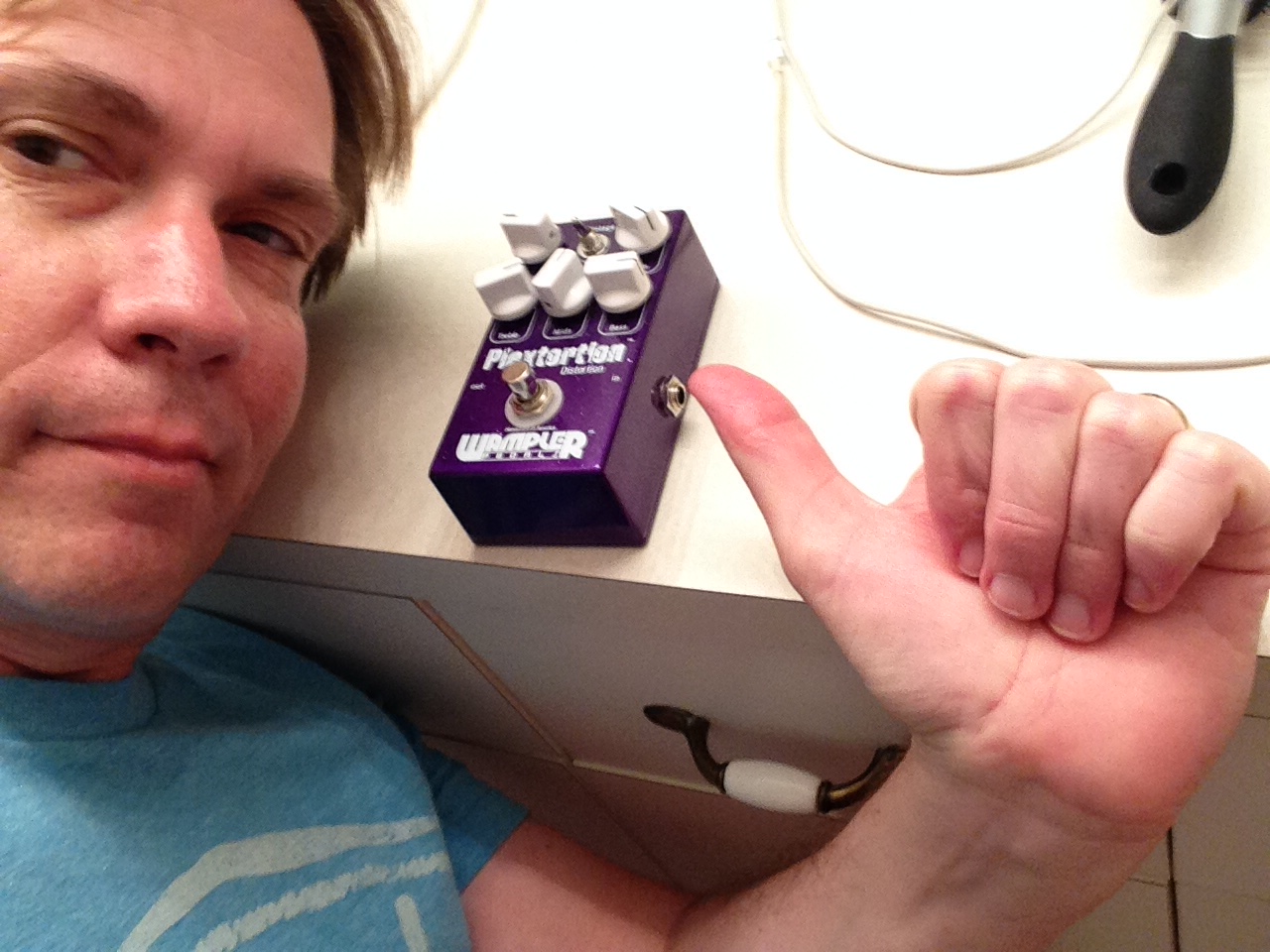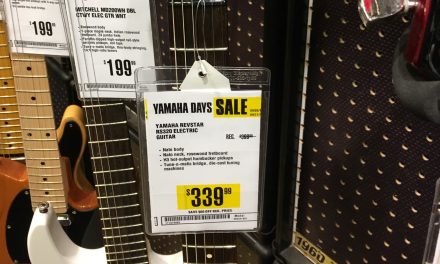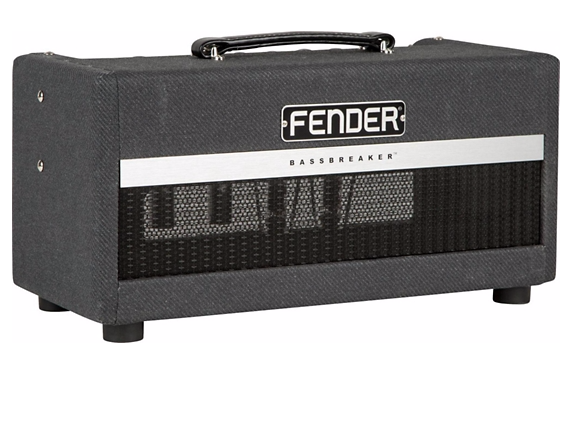Updated on June 24
Stupid Hot Rod Deluxe. You know it, I know it, everyone knows. The clean channel sounds good – the big, open back cabinet design and Celestion speaker sound big, much bigger than its younger brother the Blues Junior. People like the clean sound, but the dirty channel? Craptacular. I’ve got a Peavey Valveking MicroHead, and if you know how to use the EQ section, it does crunch and over the top distortion very well. So I don’t need a good dirt tone from my HRD. Do I?
Well, yes. I record music. I sell my music online via iTunes and via streaming and via music licensing. I get checks in the mail. They’re small but I love them. And I want more than just a single amp’s dirty tone. I needed a distortion pedal. But which one?
I spent the past month or two going to Guitar Center and Sam Ash and trying out pedals. In the end I narrowed it down to the three I liked best – the Dirty Little Secret by Catalinbread, the Pinnacle by Wampler, and the Plextortion by Wampler. I ended up buying the Plextortion. You’ll see why in a minute. But first I have to talk about the dickhead kid playing Rush badly.
I’m at the Sam Ash in Tampa and the sales girl gets the Pinnacle and the Dirty Little Secret out of the display case for me. She asks which amp I’d like to play through and I laugh and tell her the Hot Rod Deluxe. So I get a Strat, I set it up, and I start tuning. Or trying to. There’s a teenage boy, looked about 17, on the other side of the amp display. I’m trying to tune and I can’t because he’s playing bad metal licks the whole time. I turn my amp up a teeny bit so I can hear to tune, and he glares at me and turns his amp up louder.
Times like that, you feel like the Terminator, choosing your response from a menu. I selected the best option. I just turned the amp off and started unplugging the cables. One of the sales guys asks me if he can help with anything. And I say, loud enough for half the store to hear, “I’m just going to move down to the other end of the room. I can’t even tune the guitar because he’s playing so loud.” And the sales guy helped me carry the pedals down to the other end. I plugged into a big Blackstar and was able to try to the pedals out. Meanwhile the sales guy is apologizing to me and I say “No big deal. I just couldn’t hear anything.” Another sales guy was talking to the kid, who was playing Limelight badly. He stopped playing. Two minutes later he left the store. Mission accomplished.
Anyway, the Dirty Little Secret was a great sounding pedal. I liked it. I liked the Pinnacle, but to me it didn’t sound good when you tried to get a crunch sound out of it. It was designed for all out dirt. At the Guitar Center in Tampa I tried out the Plextortion. Eventually I went back and bought it. Why didn’t I buy it from the Guitar Center in Clearwater, with my favorite manager (Kevin?) They didn’t have it in stock.
575 words in and I’m finally getting to the pedal. Overall, I like this pedal a lot. Here’s the good, bad, and ugly…
The Good
The Plextortion is supposed to sound like an 80’s metal band Marshall, and it does. If you want to play the opening riff to “Sweet Child of Mine” it will get you there. The EQ is responsive, and you can dial it way back and get some good AC/DC type tones out of it. Pretty good crunch sound. When you max it out, it has a nice singing quality. And it’s super quiet for a dirt pedal. I was able to get a good sounding distortion from my HRD for the first time. I was happy I bought it.
The Bad
This pedal sounds very good, but not as good as the dirty sounds I can get from my Peavey Valveking MicroHead. When you turn the distortion up all the way, it gets plenty nasty, but if you want to grab those squealing harmonics, it’s not as easy as it should be. I don’t do that much, but if I wanted to, it’s not as good as the Peavey. The bass knob can cut just fine, but it doesn’t really boost that much – not like the treble and mid knobs.
The Ugly
To my ears, this pedal doesn’t work so great with single coil pickups. It was designed to sound good with humbuckers and it does, but single coils sound buzzy through it, to my ears. You can tweak it and get it sounding decent with single coils, but not great.
Conclusion
It was a good buy. I think it sounds very good, and I’m happy with it assuming I’m using humbuckers. Wampler discontinued this pedal, probably because the demand for it ran its course. It definitely gives me a sound that’s different than the Peavey. And for recording, you want to have a wide range of tones available. If you want to sound like AC/DC, the PlexiDrive is better. If you want to sound like Van Halen, the Pinnacle is better. But if you want to sound like both and all points between, the Plextortion is a great choice. You can still find them out there at some music stores and online. Yes, it’s a $200 pedal, and that’s not “budget” in some people’s eyes. But it is cheaper than buying a new amp.
Update
Here’s the new part. With some suggestions from the Wampler group on FriendFace, I think I’ve nailed down the best way to use this pedal with single coils. You start by setting it up to sound as close to the amp’s clean sound as possible. Then you start tweaking. I’m not changing my opinion – I still think this pedal is a better match with humbuckers. It’s supposed to be. I think for single coils I may need a different pedal. But that’s OK. If you want the best possible sound, even on a budget, you probably need to specialize. I also found one really co0l way to make the pedal sound great with single coils. I brag on my Peavey Valveking Microhead all the time, because to me the dirt channel is very close to a good Marshall. But even at it’s lowest setting the dirt channel is still too dirty for my Strat, where I want just a hint of breakup. The Plextortion can help with this. I set it neutral with not much gain added and use the volume to control what goes to the Peavey. Best of both worlds? Maybe. There are no rules.
But yeah, this pedal is great for humbuckers and decent for single coils.





